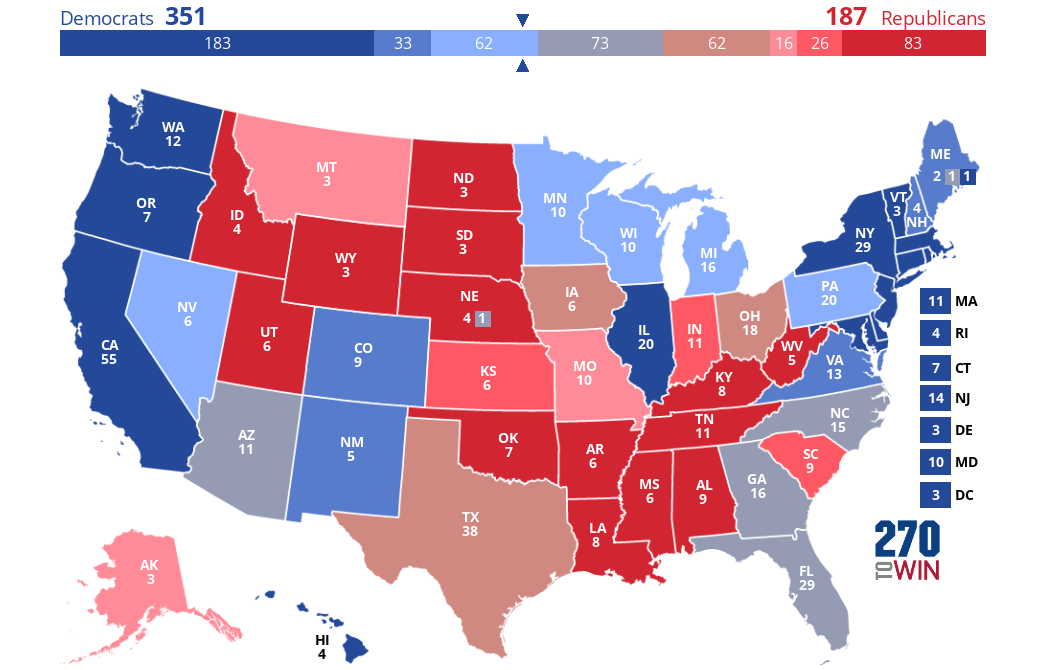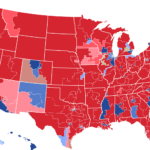Despite numerous claims to the contrary from across the political spectrum, we should know in relatively short order tomorrow night who the next President of the United States is, whether that’s a continuation of the Donald Trump presidency, or far more likely, Joe Biden elected as the 46th President after serving as Vice President for eight years before Trump was elected.
Why is Biden the clear favorite? he has a 7 to 10 point national lead, and has far more paths to the 270 electoral votes needed to win the Presidency than the incumbent Trump. Trump could pull another upset, but that hasn’t been likely since COVID-19 hit the United States, and the ebbs and flows of the Presidential race issue wise, have done little to improve the President’s standing with key voting blocs, or help him expand support beyond a vocal but demographic minority base of around 42% of the voting public. No matter what Trump or Biden do, it’s hard to get Trump below 40%, but the path to a closer national margin, and with it a far better shot at hitting 270 in the electoral college, remains narrow, and has only gotten narrower since Biden locked down the Democratic nomination, and then won or drew both of the national debates (with the other being cancelled).
We’ll take a look at each state and an electoral college prediction below, but the fundamentals are this, Trump was rejected in the 2018 midterms, suffering setbacks in a number of key states for his 2020 prospects, pre-COVID with the economy relatively healthy, he had a credible shot at beating Biden in the electoral college, even if he lost the popular vote again, but since the virus wrecked America’s economy, health, and national morale, he’s been unable to find a way out of the mire he’s stuck in. Tangents on “law and order”, decent economic numbers this fall, and a relatively sanguine Biden campaign have been nothing but blips on the big picture. Biden has run a normative campaign to try to give the public confidence in his leadership during a difficult time, and much like how it worked out in the primary, it will almost certainly work out in tomorrow’s general election. Trump by contrast has been all over the place, spending most of the time trying to please his base, not the voters who are anxious about his leadership. Women have broken in Biden’s favor, and they vote at higher rates than men.
100 million voters have already cast ballots early, and we’re headed for record turnout for the modern era once all of tomorrow’s votes are tabulated. This is not the depressing contest that was the 2016 election, and voters across the political spectrum are taking it far more seriously, relatedly, third party support has collapsed, hurting Trump’s chances further. The Trump campaign’s posturing in the final weeks of the campaign has also not been from a place of confidence, you cannot litigate yourself out of an 8 point national loss, and election day turnout alone, even if it’s more favorable to Trump in some states, will not erase what was lost to Biden in mail and early voting. The national electoral vote projection is 351 to 187 for Biden.
Likely and Safe Republican States
The Safe and Likely Republican states are white majority states in the South, Appalachia, and Mountain West, of note to watch here are Trump’s margins with LDS (Mormon) voters in Utah and Idaho (and the far more competitive Arizona and Nevada), and Trump’s retention of support in Appalachia where he made massive gains from Romney’s numbers 4 years ago, and the suburbs of the Deep South, places like Huntsville, Alabama, and the New Orleans, Louisiana suburban parishes. Trump will win these states, but could continue to bleed vote in the suburbs much like what happened in 2018 (and what got Alabama Senator Doug Jones, Kentucky Governor Andy Beshear, Louisiana Governor John Bel Edwards elected/re-elected).
The three likely Republican states are margin checks for Trump in politically evolving South Carolina and Kansas, and former swing state Indiana, a state Obama won in 2008 but has otherwise been comfortably red, especially with former Indiana Governor and now Vice President Mike Pence the steady hand on Trump’s ticket. Indiana polls close first, and a low margin (or even a shocking loss) in Indiana would be the canary in the coal mine for Trump’s overall performance. Kansas is one of the most Republican states in America, but it elected a Democratic Governor and other Democratic officeholders in 2018, it has a competitive Senate race, and the growth of wealthier, better educated suburbs vs the traditional rural and agricultural vote is benefitting Democrats. In South Carolina record black turnout will be needed to make the state competitive, but margins in suburban Greenville and Charleston will be interesting to watch. South Carolina could be the next North Carolina or Georgia in a few years, and Trump is almost certain to lose vote share vs 2016, even if the state is out of reach for Democrats because of its strong conservative undercurrent.
Lean Republican States (MO, MT, AK)
I’ve been bullish on Biden’s chances in Missouri, Montana, and Alaska, so much that I have them in the lean Republican column. If the floor falls out from Trump on election day, record voter turnout would put these states in the danger zone for flipping to Biden. Only a rout scenario produces that outcome, but all the same Missouri margins have been stubbornly close, even in Republican internal polls, despite how safe it was for Trump in 2016 (and the state has been competitive previously). Montana is shattering turnout records, has a competitive Senate race, and is not as doctrinaire conservative as many of the Trump states, while Alaska is hard to poll and will occasionally vote Democratic. Biden should surprise margin wise in all three, and make big gains in places like Anchorage, Alaska and St. Charles county Missouri, but it still won’t be enough to win them. Trump has made little effort to arrest his slide in these states, in part because his campaign has run out of money in the closing weeks.
Tilt Republican States (TX, OH, IA)
Texas, Ohio, and Iowa are the states Trump will most likely hold from 2016, but by narrow margins. Ohio and Iowa were relative blowouts in 2016 compared to their normal swing state status, but Trump’s decline among northern whites vs his 16 numbers, and Biden’s relative appeal to the midwest has brought them back into frame. Biden has chosen to devote resources to all three states, including a late stop in Cleveland, Ohio, and as of this article, they remain too close to call with any certainty. With that said, Iowa and Ohio should be Republican oriented enough to stay in Trump’s column, even narrowly, Dems were burned in the 2018 midterm in these states. Trump has to win all three, and Biden can still get to 270 without them
Texas is an entirely different story, Texas has been the blue mirage for Democrats over the last decade, the state wasn’t in frame for the party during the Obama era, but Beto O’Rourke made Democrats believe they could win the state after he came up just short against Ted Cruz in 2018. A number of “demographics are destiny” champions in the party (and Texans) have demanded Biden invest more in the massive, and expensive state that’s diverse and growing, but he’s chosen to take record fundraising and hedge in the state, investing some but not going all in. Democrats are almost certain to improve in the suburbs, putting the Texas State House in play, and ensuring Dems will gain in Congress in the Lone Star State, but statewide victory should remain just out of Democrats grasp largely due to Trump’s modest improvement in standing with Latinos, and the general long running relationship that R’s have with Latinos in the state that they lack in a lot of other places. Record voter turnout is going to produce some surprising results, and the polls are mixed here, but I’ll still go with the median outcome being a narrow Trump victory, the question is whether Dems can keep chipping away in future cycles, or whether Trump is just historically unpopular in an otherwise red state.
Tilt Democratic States (FL, GA, NC, AZ, ME-02, NE-02)
The good news for Joe Biden? flip all of these states to Trump’s column, and Biden still wins 278-260 in the electoral college. All of these states are pure swing states, with Georgia and Arizona new entrants in this category, while Florida, North Carolina, and Congressional Districts in Maine and Nebraska that were Trump curious in 2016 back in the toss up category again.
Florida has frustrated Democrats for 20 years now, the state has diverse and urban pockets, but Republicans have a strong political machine, the senior vote has traditionally been R leaning in a state full of retirees, and many of the State’s Latinos, especially Cubans and more recently Venezuelans in South Florida are politically conservative and distrusting of anything left leaning politically because of the history in the heritage countries. With that said, Florida is always close, and it will be close, but what’s working in Biden’s favor is a relative advantage with NPA/independent voters, and big gains among seniors, especially in the Tampa and Orlando media markets. Districts that went for Trump by credible margins, or were at least competitive, in places like Pinellas, Hillsborough, Sarasota, Duval, and Polk County have started to shift back towards Biden. Meanwhile a mail voting advantage for Democrats for the first time ever, and an early voting advantage for Republicans, which is also a change from the norm, has fought itself to a wash, with both parties more or less producing equal turnout, and Democrats holding a narrow edge of just over 100,000 votes going into election day. The margin in Florida should be within 2.5%, but whatever Trump gains have been made in Miami-Dade (that pulled Republicans over in 2018 in the state) are likely to be negated by his poor numbers with seniors. Dems are unhappy with the campaign outreach in this state and they remain wary of Florida politically, but it’s more likely than not that new Florida resident Trump will be the one disappointed on election night.
Georgia is another state where Democrats came up just short in 2018, but in the Peach State they are feeling much better about their chances, at least at the top of the ticket. Georgia’s suburbs have seen record early and mail voter turnout, affluent college educated whites in particular raced to the polls, while Trump is looking to make up the margin on election day, especially with the state’s white working class and in rural and exurban areas. Both campaigns have flocked to the state, and remain optimistic. The result will likely hinge on whether Democrats can mobilize more of their rural, and urban downscale electorate on election day in reliably blue places like Albany in Southwest, Georgia and Clayton County, just south of the City of Atlanta. Biden will post much better numbers than Stacey Abrams did in more upscale suburban and exurban communities like Gwinnett (safe Biden), and Forsyth (safe Trump), and is overperforming with white voters, but the GOP has slowly been waking up a turnout machine to try to avoid the disaster of losing Georgia for the first time since the Clinton administration. In the end, it’s probably too little too late, if Democrats can chase down enough late votes, Republicans were too slow to react in Georgia and will be bitter about the result. Even a modest improvement from 2018 would put Dems over and they’ve run a better effort in the state this year.
In North Carolina, a state that was marginally seen as a better opportunity for Biden than either Georgia or Florida, Biden has maintained a credible but narrow lead. Democrats roared out to an advantage with early and mail voting, Trump has reeled that back in, and the Democratic infrastructure in the state leaves plenty to be desired, but you just can’t ignore the small but stable Biden leads in the state and the fact Trump has been forced to make a late push here. Popular Democratic Governor Roy Cooper has earned praise for his handling of COVID-19 from state residents, and will be one of the main reasons Biden gets dragged over the line.
Arizona flipped to Democrats in a surprise in 2018, and Trump’s continued weakness with suburban and LDS voters, and his attacks on the McCain family all but ensured he would have a difficult path towards winning in 2020. This is a diverse state where much of the vote is early and by mail, and Trump’s weakness with seniors has been a major problem towards his chances. Trump has closed the gap some, but the Arizona GOP is a dumpster fire, and a small but steady Biden can’t be ignored when so much of the vote is banked already. The Phoenix media market (which most of Arizona lives in) was the hottest in the country spending wise this year, and it appears Biden has come out ahead.
Maine’s 2nd Congressional district is a white working class, lesser educated district where Trump did well, but Democrats flipped it back in 2018 for Congress and are now safe to hold the seat. Polling is hard to reliably evaluate in the district, but Biden’s improvement with the northern white working class should be enough to get him over the line. Nebraska’s 2nd Congressional district is Suburban (Omaha), and is a classic district where Biden has improved markedly on Clinton, presumably enough to win.
Lean Democratic States (NV, MN, WI, MI, PA)
The most critical state in Biden’s coalition is Pennsylvania, it’s also where Trump has bet the house on pulling a comeback and Biden has devoted the most time. This state is a bit of a snapshot of America, with diversity in some pockets, and credible urban, suburban, and rural electorates, along with mixes of wealth and prosperity and declined rust belt areas facing off. Pennsylvania native Biden has proven to be a good fit though, he’s maintained a narrow but steady polling lead in the state (notice a trend), should pair gains in the suburbs around Philadelphia with doing just enough in the traditional union, resource extraction, and manufacturing communities to the west where Trump performed so well. Democrats won big in this state in 2018, and though Trump has held his ground better than that, it would take something shocking to see Biden not hold on.
In Nevada, where much of the vote is early and by mail, Democrats built up another big firewall in Las Vegas that should be strong enough to hold off any Trump surge in the rural parts of the state. Most of the population lives near Las Vegas, and the Union machine that Democrats built there has adapted well enough to the pandemic. Trump has made claims he will win Nevada, but the evidence is missing.
The same can be said of Minnesota, where a slow but steady shift to the right in rural and satellite parts of the state has been counteracted by Democratic gains in the Twin Cities and its associated suburbs where a majority of the state population is. Though the coalition has changed in this state, that coalition still nets out to a Biden win, as even riots in Minneapolis weren’t enough to put Trump in a winning position there.
Wisconsin and Michigan have been the biggest disappointments for Trump. The Republicans lost both states in 2018 after Trump had “cracked the blue wall” to win the election against Clinton in 2016. Trump’s constant attacks on Michigan’s new Democratic Governor Gretchen Whitmer has not helped him at all, and he’s shed ground in both the Milwaukee, and Detroit suburbs, areas where Republicans used to dominate. The state’s liberal college educated areas have seen massive turnout (Madison, Wisconsin has some of the highest voter turnout in the nation), and even more rural areas seem less favorable to Trump than four years prior such as Michigan’s UP and Wisconsin’s Northwoods region. The shift in Wisconsin and Michigan should mirror the national shift from 16->20, and Biden is set to win back two states that he won twice on the ticket with Obama.
Likely and Safe Democratic States
Trump has done nothing to put most Clinton states in play, Virginia continues its lurch to the left from former swing state status, Colorado and New Hampshire have also moved modestly left, and the Trump campaign abandoned efforts to put New Mexico into play despite reasonably favorable demographics. Millions of people will vote for Trump in California and New York, but that will still be less than 2016, and it won’t impact the national outcome because we don’t have a national popular vote system. Watch for Biden to improve on Clinton’s margins in upstate New York, and the Virginia’s DC suburbs continued march to the left.
Main Photo:



 Click the map to create your own at
Click the map to create your own at 










